



Targeting translational Using Pet Dogs To Identify Effective Treatments for Spinal Cord Injury Sarah Moore, DVM, DACVIM (Neurology) The Ohio State University Department of Clinical Sciences
Focus on secondary injury in experimental (rodent) contusion models… Billions of dollars Many careers Result?
The Result…
People, not so much… No successful treatment translation Failure of multiple promising drugs in human trials 80% remain AIS-A (sensorimotor complete) 10% convert to AIS-B (regain some sensation) 10% convert to AIS-C (regain some motor)
What is getting “lost” in translation? Carefully controlled lesion type/severity Lack of genetic diversity Treatments applied at impractical time-points Outcome assessments that aren’t realistic Issues with scaling up drug dose Immunological differences? Inability to replicate a clinical setting And so on…
Using SCI in veterinary patients to model human disease
Why a spontaneous dog model? The value of experimental models Need for efficiency in translational therapeutic development The value of natural disease models Similar spinal cord size and complexity Genetic and clinical heterogeneity Ability to conduct a “clinical trial” Ethical considerations
Different injuries… …. Similar lesions Primary injury: Hemorrhagic, necrosis, primarily gray matter Fracture or other Shearing of neural cell membranes and connections 16% Relative sparing of sub-pial axons Laceration, severing of cord in traumatic SCI; function severing in IVDE Intervertebral disc extrusion Secondary injury: 84% I schemia Ionic disturbances Inflammatory responses Neuronal excitotoxicity Formation of glial scar
Canine clinical SCI 20-30,000 cases per year in US alone Most IVDE-associated 15% are sensorimotor complete lesions (AIS-A equivalent) Statistical power Clinically relevant outcome assessments Open-field locomotor scores Quantitative sensory testing Kinematics Spasticity Urodynamic studies Cost Opportunities for bi-directional advancement
Individual demonstrations of feasibility
A canine spinal cord injury consortium: CANSORT-SCI Group of 9 veterinary institutions working in dog models of SCI The Ohio State University Texas A&M North Carolina State University Bristol- UK Hannover, Germany SCI Physical therapist Bern, Switzerland SCI Physicians Purdue University Royal Veterinary College Spinal cord injury researchers Pharmaceutical companies
Canine disease model of SCI- uses What questions can we answer Second species confirmation of effect Influence of intervention on clinically relevant outcome measures Confirmation of effect in a “clinical” population Safety/toxicity and dosing refinement questions Immune-response studies Chronic injury populations Effect of comorbid conditions
Canine disease model of SCI- uses What questions can we not answer There is no “universal” model Many tissue-based questions Initial definition of mechanism Early drug discovery studies Studies that require carefully timed injury- intervention relationship
Recommend
More recommend